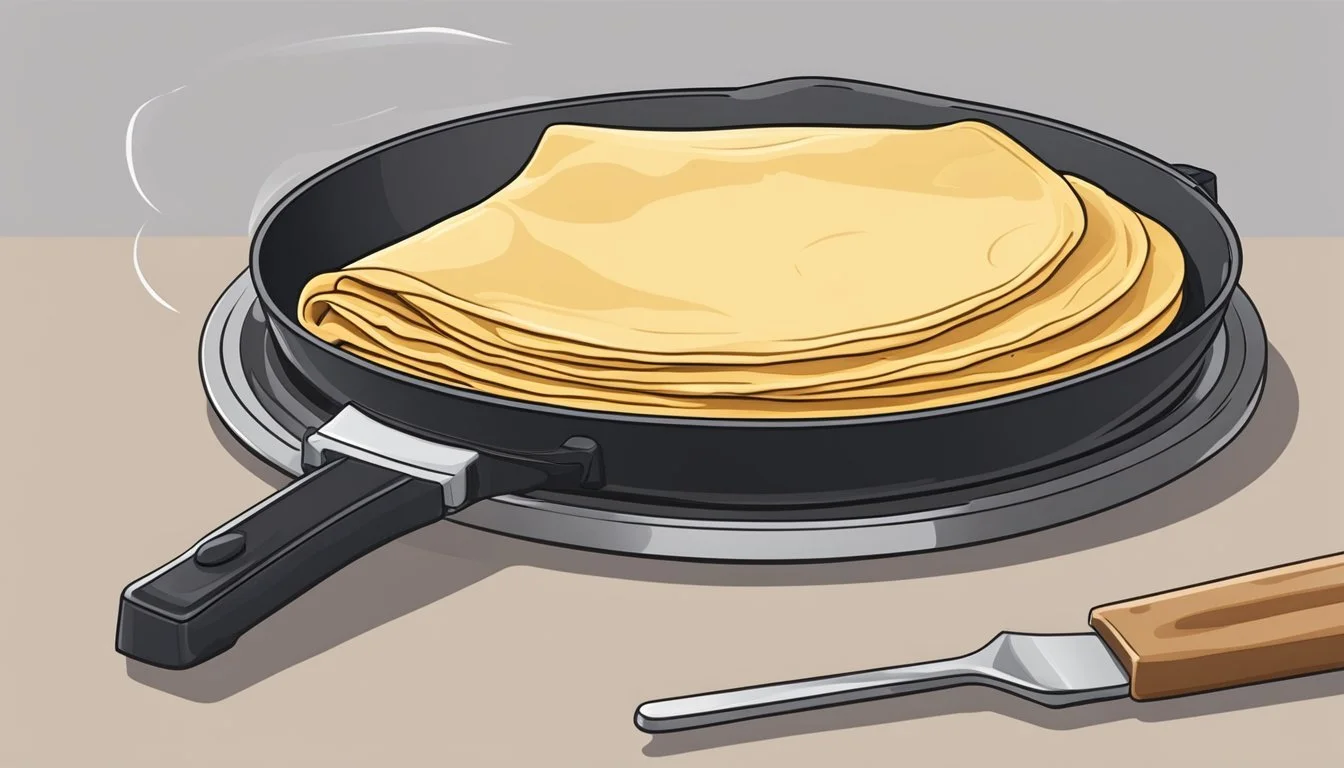How to Reheat French Crepe
Best Methods for Perfect Texture
Reheating French crepes to maintain their delicate texture and delicious flavor can be a challenge, but with the right methods, it is entirely achievable. Whether you prefer the convenience of a microwave or the even heat of an oven, mastering these techniques ensures your crepes remain as delightful as when first made. To reheat French crepes, place them on a microwave-safe plate, separated by lightly dampened paper towels, and microwave for 30 seconds to one minute.
For those who appreciate traditional methods, using an oven is another excellent way to reheat crepes without sacrificing quality. Preheat your oven to 350°F, wrap the crepes in foil, and heat them for about 5 to 10 minutes. This approach helps maintain their moisture and prevents them from becoming rubbery.
Each method has its advantages, and the choice ultimately depends on personal preference and convenience. The key is to preserve the crepes' moisture and avoid high temperatures that could alter their soft and tender consistency.
Understanding Crepes
Crepes are thin French pancakes, distinct in flavor and texture. They can be sweet or savory, depending on the ingredients and fillings used. This section explores key differences, types, and the preferred texture and freshness.
Crepes vs Pancakes
Crepes differ from pancakes mainly in texture and thickness. While pancakes are thick and fluffy, crepes are thin and delicate. The batter for crepes includes flour, eggs, milk, and often vanilla extract for sweet variations, giving them a smooth, light texture. In contrast, pancake batter includes baking powder or soda, resulting in a more substantial, airy texture. The absence of these leavening agents in crepe batter is essential for achieving their paper-thin consistency.
Sweet vs Savory Crepe Varieties
Crepes come in two main varieties: sweet and savory. Sweet crepes are usually made with a touch of sugar in the batter and have fillings like fresh fruit, chocolate sauce, or lemon juice. Savory crepes, or galettes in France, often use buckwheat flour and are filled with ingredients like cheese, eggs, ham, and even vegetables. The difference in fillings makes each variety unique and suitable for different meal occasions, whether it's breakfast, lunch, dinner, or dessert.
Ideal Texture and Freshness
The ideal crepe should be soft and slightly elastic but never rubbery. Freshness is key to maintaining quality, as crepes tend to dry out quickly if left exposed. To keep crepes fresh, they should be stacked with parchment paper between each one and covered or wrapped tightly. If reheating, it is important to maintain their softness and light texture, avoiding high temperatures that might make them tough. Proper reheating methods help in preserving the crepe's ideal qualities, making them taste as close to freshly made as possible.
Pre-Reheating Tips
Prior to reheating French crepes, proper storage and thawing techniques are essential to maintain their texture and flavor. Ensuring the crepes are stored correctly will prevent them from becoming dry or soggy.
Proper Storage Techniques
Storing crepes correctly is crucial. Once cooked, crepes should be cooled to room temperature before storage to avoid condensation.
Using an airtight container is recommended to maintain freshness. Placing parchment paper or wax paper between each crepe can prevent sticking.
For short-term storage in the fridge, wrap crepes tightly in plastic wrap or aluminum foil.
For long-term storage, freeze crepes by layering them with parchment paper and sealing them in a freezer-safe container. This prevents freezer burn and preserves their quality.
Thawing Frozen Crepes
When ready to reheat, allowing frozen crepes to thaw is essential.
Remove the crepes from the freezer and leave them in the fridge overnight. This gradual thawing preserves texture.
For a quicker method, crepes can be left at room temperature for about an hour. Avoid using hot water or direct heat, as this can cause them to become rubbery.
Ensuring the crepes are fully thawed before reheating helps achieve even warming and maintains their delicate structure and flavor.
Reheating Methods
Reheating crepes to maintain their delicate texture and flavor is crucial. The ideal methods involve consistent, moderate heat to prevent them from becoming rubbery or dry.
Oven Reheating
Preheat the oven to 350°F (180°C) for even heating. Place crepes on a baking sheet lined with parchment paper. Cover them with aluminum foil to retain moisture.
Arrange the crepes with some space in between.
Heat for about 10 minutes.
If you prefer crispier crepes, remove the foil for the last 2 minutes.
This method ensures even warming without overcooking.
Stovetop Reheating
For stovetop reheating, use a non-stick skillet or crepe pan over medium-low heat. Lightly coat the pan with cooking spray or a small amount of butter.
Place one crepe at a time into the skillet.
Warm each side for 30-60 seconds.
Flip carefully to avoid tearing.
This method provides quick reheating and crisp edges if desired.
Microwave Reheating
Place crepes on a microwave-safe plate. Cover them with a damp paper towel or plastic wrap to lock in moisture.
Microwave on medium power for 10-20 seconds per crepe.
Check for warmth and avoid overheating.
This method is fast but can make crepes a bit soggy if overheated.
Alternative Methods
Air Fryer: Set to 350°F (180°C). Wrap crepes in foil and heat for 2-3 minutes. Remove foil for crispy edges.
Toaster Oven: Similar to the oven method. Set to 350°F and heat wrapped crepes for 5-7 minutes.
Steamer Basket: Place crepes over simmering water and cover. Steam for about 2-3 minutes to reheat gently.
These methods offer versatility, ensuring your crepes stay delicious.
Additional Tips for Best Results
To achieve the best results when reheating French crepes, it is crucial to focus on preventing overcooking, retaining moisture, and enhancing flavor and presentation. These tips will help ensure the crepes remain delicious and appealing.
Avoiding Overcooking
Overcooking can make crepes rubbery and unappetizing. Using medium or low heat is essential. High heat can cause the delicate texture to suffer. When reheating in an oven, preheat to around 300°F (150°C) and warm the crepes gently. Microwave reheating should be done in short intervals—about 30 seconds at a time—to prevent overheating.
If using a skillet, a non-stick one works best with a quick warming of around 1-2 minutes per side. Regardless of the method, monitor the crepes closely to avoid drying them out.
Maintaining Moisture and Softness
To keep the crepes from drying out, maintaining moisture is key. Brush each crepe lightly with butter or oil before reheating. Adding a damp paper towel when using the microwave can also help retain moisture. In the oven, stack crepes with parchment paper between them and cover the stack with foil.
Another trick is to sprinkle a few drops of lemon juice on the crepes before reheating, which can also enhance their softness. These steps help preserve the ideal texture and prevent crepes from becoming too dry.
Enhancing Flavor and Presentation
Adding a touch of butter before reheating can boost flavor. For adding visual appeal and balance to the crepes, consider garnishing with powdered sugar or fresh fruit. Top with fillings like Nutella, whipped cream, or fresh berries to make them more delectable.
Layering in toppings such as a sprinkle of nuts or a drizzle of syrup can also make a difference in both taste and presentation. Arrange the crepes neatly on the plate to enhance their visual appeal, ensuring they look as tasty as they are.
Serving Suggestions
Whether enjoyed for breakfast, brunch, or dessert, French crepes can be paired with a variety of accompaniments and beverages to enhance their flavors. Below are some options to elevate your crepe-serving experience.
Accompaniments
Sweet Crepes: Enhance sweet crepes with whipped cream, fresh fruit like bananas and strawberries, and chocolate sauce. Sprinkle sugar or drizzle syrup for extra sweetness. Classic options include spreading a light coat of lemon juice and sugar for a refreshing taste.
Savory Crepes: For savory varieties, fillings such as meat and cheese are excellent. Serve alongside fresh greens or a light salad. Some popular combinations include ham and cheese or spinach and ricotta. Add a touch of freshness with a side of cherry tomatoes or roasted vegetables.
Beverage Pairings
For Breakfast and Brunch: Pair sweet crepes with coffee or a cappuccino to complement their flavors. Fresh orange juice or a smoothie made with berries can add a vibrant contrast.
For Dessert: Serve sweet crepes with a hot chocolate or a cup of tea. A dessert wine such as Moscato can also enhance the flavors.
Savory crepes pair well with white wine for a more sophisticated touch. A light beer can also be a refreshing choice, especially if the crepe has hearty ingredients.
Troubleshooting Common Issues
When reheating French crepes, common issues can affect the texture and taste. This guide addresses how to maintain crispness or softness and how to prevent tearing and stickiness.
Preventing Tearing and Stickiness
Tearing: Tearing is a common mistake when handling delicate crepes. To avoid this, ensure the crepes are fully thawed if they were frozen. Use a non-stick skillet with a light coating of butter to provide a smooth surface, reducing the chance of tearing.
Stickiness: Stickiness often occurs if the crepes are reheated too quickly or at too high a temperature. When simmering, use moderate heat and gently reheat the crepes. If using a microwave, cover the crepe with a damp paper towel to retain moisture without becoming too sticky.
Adjustments for Different Crepe Types
Sweet Crepes: Sweet crepes can dry out quickly due to added sugars. To maintain softness and avoid a rubbery texture, reheat them on medium heat for a shorter duration. Use a lightly buttered skillet or wrap in plastic wrap before microwaving to keep them moist.
Savory Crepes: Savory crepes often contain fillings that require an even temperature to reheat properly. Reheat in a covered steamer basket to evenly warm both the crepe and filling, ensuring that the texture remains tender. If using the oven, preheat it to around 300°F and cover crepes with foil to keep them from drying out.
Employing these tips helps preserve the best qualities of various crepe types and ensures a delightful reheated experience.
Conclusion
Reheating French crepes effectively requires careful attention to preserving their delicate texture and flavor. Application of optimal reheating methods ensures quality and balance, aligning with the versatility of French cuisine.
Recap of Best Practices
Maintaining the quality of French crepes when reheating is essential. The oven method stands out as one of the best practices. Preheat the oven to 350°F, wrap individual crepes in foil, and warm them for about 10 minutes.
Using parchment paper between stacked crepes, coupled with a light butter brush, can enhance moisture and flavor. An alternative is the microwave method, useful for quick reheats. Cover the crepe with a damp paper towel and microwave for 30 seconds, adding in small increments if needed. This prevents the crepes from becoming rubbery.
Final Thoughts on Reheating Crepes
Achieving the perfect balance when reheating crepes is critical to enjoying their original taste and texture. Methods such as using the oven or microwave ensure convenience and versatility while preserving quality.
Wrapping crepes in foil for the oven method or using a damp paper towel in the microwave can significantly improve the reheating process. Each method lends itself to different needs, providing flexibility in preparation.
Ultimately, the right approach depends on personal preference and time constraints. By following the outlined practices, anyone can enjoy reheated crepes that closely match their freshly made counterparts.







